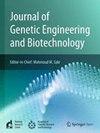Molecular characterization of chromium tolerant and gelatin hydrolyzing bacterial isolates from tannery wastes: Perspective on chrome-tanned leather waste biodegradation in Bangladesh
IF 2.8
Q3 Biochemistry, Genetics and Molecular Biology
Journal of Genetic Engineering and Biotechnology
Pub Date : 2025-03-28
DOI:10.1016/j.jgeb.2025.100479
引用次数: 0
Abstract
Improper management of chrome-tanned leather waste (CTLW) might potentially cause adverse environmental consequences. To mitigate that harmful impact, this study aims to find and conduct molecular characterization of bacteria from tannery wastes that can tolerate chromium (Cr) and hydrolyze gelatin. Bacteria from tannery wastes are naturally adapted to Cr; eight Cr(III) tolerant bacteria, namely bacterial isolate (BI) 1 to 8, were isolated from the collected waste samples. The isolated bacteria showed the maximum tolerance concentration (MTC) range of 700 to 1500 ppm for Cr(III) and 200 to 600 ppm for Cr(VI). Physiological and biochemical analysis, including the gelatin hydrolysis activity, identified those isolates up to the genus level. Among the isolates, BI 4, 5, and 7 were able to hydrolyze gelatin. Therefore, 16S rRNA molecular characterization was conducted for those isolates, which confirmed BI 4, 5, and 7 as Bacillus wiedmannii (Accession No: OR564007), Enterococcus faecium (Accession No: OR564008), and Bacillus cereus (Accession No: OR564009), respectively. Bacteria with gelatin hydrolyzing activity can be the potential for degrading hydrothermally treated CTLW. Thereby, those three isolates were applied to explore their biodegradation ability in real world scenario. The biodegradation experiments showed that Enterococcus faecium, Bacillus cereus, and Bacillus wiedmannii were able to biodegrade hydrothermally treated CTLW at 98.67 %, 98.33 % and 98.00 %, respectively. The present study demonstrates Enterococcus faecium, Bacillus cereus, and Bacillus wiedmannii having biodegradation of CTLW applications might mitigate environmental pollution caused by this waste in the perspective of Bangladesh.

从制革厂废物中分离的耐铬和明胶水解细菌的分子特性:孟加拉国铬鞣皮革废物生物降解的观点
铬鞣皮革废料(CTLW)管理不当可能会造成不利的环境后果。为了减轻这种有害影响,本研究旨在从制革厂废物中找到能够耐受铬(Cr)和水解明胶的细菌并进行分子表征。制革厂废物中的细菌自然适应铬;从收集的废物样品中分离出8株Cr(III)耐受性细菌,即细菌分离物(BI) 1 ~ 8。分离的细菌对Cr(III)的最大耐受浓度(MTC)为700 ~ 1500 ppm,对Cr(VI)的最大耐受浓度(MTC)为200 ~ 600 ppm。生理生化分析,包括明胶水解活性,鉴定这些分离物达到属水平。其中,BI 4、5和7能水解明胶。因此,对这些分离物进行16S rRNA分子鉴定,确认BI 4、5和7分别为魏德曼芽孢杆菌(Bacillus wiedmannii,登录号:OR564007)、屎肠球菌(Enterococcus faecium,登录号:OR564008)和蜡样芽孢杆菌(Bacillus cereus,登录号:OR564009)。具有明胶水解活性的细菌可以降解水热处理的CTLW。因此,这三种分离物被用于探索它们在现实世界中的生物降解能力。生物降解实验表明,粪肠球菌、蜡样芽孢杆菌和魏氏芽孢杆菌对水热处理的CTLW的生物降解率分别为98.67%、98.33%和98.00%。本研究表明,粪肠球菌、蜡样芽孢杆菌和魏德曼芽孢杆菌具有生物降解CTLW的应用,可以减轻孟加拉国的CTLW造成的环境污染。
本文章由计算机程序翻译,如有差异,请以英文原文为准。
求助全文
约1分钟内获得全文
求助全文
来源期刊

Journal of Genetic Engineering and Biotechnology
Biochemistry, Genetics and Molecular Biology-Biotechnology
CiteScore
5.70
自引率
5.70%
发文量
159
审稿时长
16 weeks
期刊介绍:
Journal of genetic engineering and biotechnology is devoted to rapid publication of full-length research papers that leads to significant contribution in advancing knowledge in genetic engineering and biotechnology and provide novel perspectives in this research area. JGEB includes all major themes related to genetic engineering and recombinant DNA. The area of interest of JGEB includes but not restricted to: •Plant genetics •Animal genetics •Bacterial enzymes •Agricultural Biotechnology, •Biochemistry, •Biophysics, •Bioinformatics, •Environmental Biotechnology, •Industrial Biotechnology, •Microbial biotechnology, •Medical Biotechnology, •Bioenergy, Biosafety, •Biosecurity, •Bioethics, •GMOS, •Genomic, •Proteomic JGEB accepts
 求助内容:
求助内容: 应助结果提醒方式:
应助结果提醒方式:


